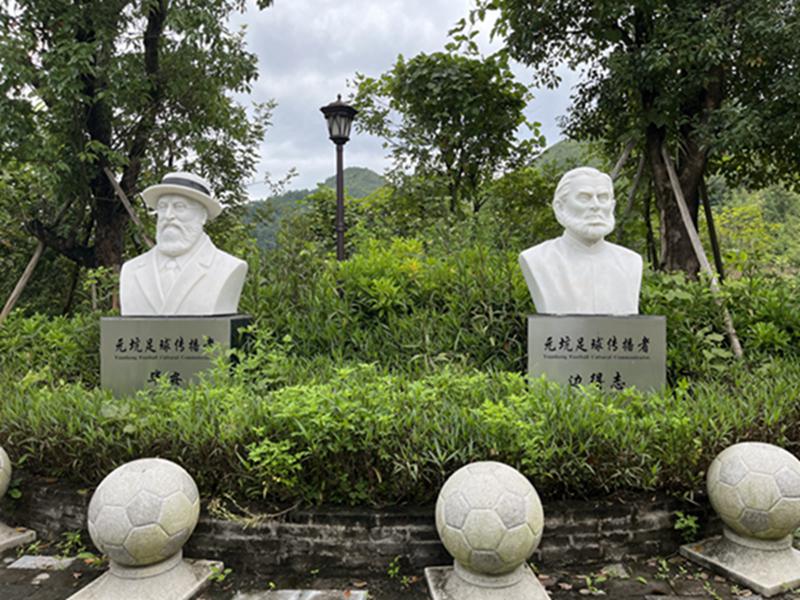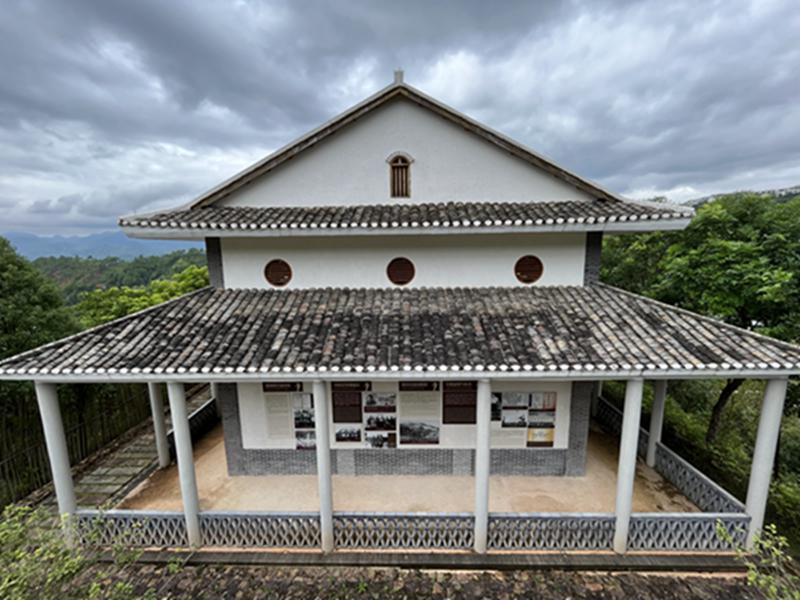Missionaries first introduced football to Meizhou in Guangdong 150 years ago, specifically the Wuhua district of Meizhou, which is known as the birthplace of modern football on the Chinese mainland. In mid-September, we visited the Yuankeng Historic Site in Wuhua to learn about the history of football, Wuhua, and the missionaries.
This historic site is a national 3A-level tourist attraction with a planned area of 16.2 acres. The site has reconstructed old buildings such as Yuankeng Middle School, the original football field, and a mountain-side running track on the original site. It opened to the public on January 16, 2021, with football culture as its central theme, featuring attractions like a football square, the Hercules Cup, a corridor with football culture, and football sculptures.
According to the "Wuhua County Chronicles," published in 1947, in 1873, two Basel Mission missionaries, Charles Piton and Heinrich Bender, founded the middle school at Yuankeng Church in Changbu Town. They constructed three European-style school buildings and established a grass football field. Using wooden materials to create goalposts, they taught students to play football, first integrating football into the physical education curriculum
In November 2015, the General Administration of Sport of China recognized Yuankeng of Wuhua County as the birthplace of modern football in Mainland China".
The pastor's house was where Charles Piton, Heinrich Bender, and some teachers lived. It was built in 1868 and covered an area of 320 square meters (0.079 acres), with only the foundation remaining today.
Piton and Bender built True Word Church in 1865, which is located further up the hill. It had a floor area of 395 square meters (0.098 acres) and featured brick and wood construction. Some rammed-earth wall foundations and nine stone column architectural components still exist.
In 2018, the government funded the construction of a church right next to the historic site, continuing to use the name "True Word Church." Local pastor Zhang introduced that because the original church was located in the scenic area, due to the demolition of the plan, believers changed to gather there now. There is currently a female pastor in her sixties responsible for the church, with around 40 to 50 attendees, primarily for Sunday services. Like many rural churches, it faces challenges such as a lack of clergy, an aging congregation, and pastoral fatigue.
On the outer wall of the church, there is an exhibit with historical materials explaining how Basel Mission missionaries brought the gospel from Hong Kong to Zhangcun Village and then to Yuankeng Village, where they built churches and schools, nurtured talent, and taught football.
In 1862, Bender arrived in China with his first missionary station in Zhangcun, Changle County, Meizhou. In 1864, Piton arrived in China and took over the Zhangcun parish. At the same time, Bender moved to Yuankeng village, which was 30 miles away from Zhangcun, to carry out missionary work.
Looking downhill from the site of True Word Church, we can see the original school buildings. In 1873, the Basel Mission assigned missionary G. A. Gussmann to assist Piton and Bender, along with students from the Theological Seminary of Basel Mission, in its construction. Today, the school building no longer stands, with only some ruins remaining.
Piton and Bender founded Yuankeng Middle School, the first secondary school that the Basel Mission established in the Hakka region of China, between 1866 and 1873. The curriculum followed a Western-style system and included six subjects: literature, science, philosophy, theology, gymnastics, and music. It also included activities like horizontal and parallel bars, gymnastics, and ball sports. One of the two most distinctive places of the school is a three-meter-wide, 400-meter-long mountain-side running track, later known as the Piton Running Track, which connected the mountain-top school building to the playground. The other is a 50-meter-long, 32-meter-wide grass football field where Bender, who was skilled in football, taught students about football knowledge and skills. It is known as the first football field in Mainland China.
Relocated in 1907, the middle school ceased operation in 1927. In the spring of 1938, local gentry proposed the establishment of a private school, Cuiwen Middle School, on the site of the former school. It is said that Cuiwen Middle School continues the excellent teaching tradition of Yuankeng Middle School.
- Translated by Abigail Wu












